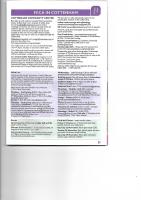Apr 2019 Tour of famous MRC Lab of Molecular Biology
Sun, Apr 28th 2019 at 2:15 pm - 3:45 pm
at short notice - a unique opportunity. Organiser Alan Franklin with Global Scholar Alex Epstein. Guests Welcome.
Today we have unique access to this cutting edge of science laboratory - the new building on the Addenbrookes site.
This lab was originally based on the University New Museum site, Cambridge where Watson & Crick cracked the DNA code and many other famous scientific discoveries were made.
Come on a special tour of the MRC Lab of Molecular Biology (LMB) where our Global Scholar Alex Epstein is working - Sunday 28th April at 2.15pm. Coffee/Tea & Biscuits included. Please be prompt to register and pick up your visitors badge.
This lab has been nicknamed the ‘Nobel Factory’ as 12 of these awards have been made for research undertaken at the LMB. It is based in a new building on our Cambridge biomedical campus, (Addenbrookes site) and it continues to lead the way in molecular research aimed at understanding and solving human health issues such as Alzheimer’s. The new site is created in 4 wings that from above resembles the X chromosome.
The building is of a innovative design specifically tailored to the science and scientists working there. Our own John Williams had a great deal to do with the build. Each alternate floor is cleverly devoted to the huge amounts of cabling, venting, air management etc needed so that ongoing maintenance does not interfere with the experiments and specialist equipment being used. Liquid Nitrogen is used routinely and high levels of this invisible gas can build up very rapidly, displacing the oxygen in the air, so the whole building has the air changed 4 times every hour and Nitrogen detectors and alarms are obvious everywhere. There are 3 Electron microscopes in continuous use plus several other types scanning machines that enable quick imaging of the proteins etc of interest.
Alex is interested in how the body ages and this year has been concentrating on the protein changes in brain cells. Proteins are strings of varying amino acids that fold in different ways and how they fold determines their function in the body. Tau is present in brain cells usually in a loosely folded form however in an Alzheimer brain a filament form builds up. Alex showed us the results of using their advanced 3D imaging computer program to visualise this abnormal Tau and 3D print it too. The program and the big data centre can take thousands of images taken by the electron microscope at random angles and combine them into a rotatable on-screen image. This technology can now quickly do what took decades to put together for Watson & Crick etc. No one knows if these changes are a cause or an effect which makes them so very interesting !
We were fascinated by the building and the work going on in it and Alex's enthusiasm for his subject was very catching. He hales from New York, has a degree from Yale, and now will start a PhD at the Rockerfeller University, New York working at a more cellular level.
Thank You So Much Alex for this tour and also what you have contributed to the life of the Club over the past year - All the Very Best in the Future !
There is plenty of good information about the lab and their research on the web site: https://www2.mrc-lmb.cam.ac.uk/achievements/
NOTE - There is secure visitor parking on site and details of site access and meeting arrangements will be in your confirmation email.
 Contact Alan Franklin about this page:
Contact Alan Franklin about this page:
'What We Do' Main Pages:
Just some of our many activities
moreOur annual charity car parking at Christmas using two car parks with the kind permission of the University and department of Chemistry raises £30,000 or more, mainly for local charities . To apply for a grant see our grant application
more
Charities are invited to submit grant applications - annually we give out over £30,000 - Fill in a Form and make your case ! Our next round of donations is open for 2025. Deadline 30 September 2025 (Now extended to 13 October 2025. THANK YOU to all applic
moreHow to join us...
more
This committee aims to put on events and support organisations that encourage and develop children and young people.
moreThe Projects Committee manages fund-raising activities and recommends the charities to receive funding to the Club Council and Business meeting. It also supports our International projects.
moreSupporting the local community is a core Rotary aim.
more
Foundation Objectives - co-ordinating international projects using Rotary grants where possible.
moreThe International projects and activities are co-ordinated within the Projects committee.
more




%20and%20a%20cross%20section%20(blue)%203D%20printed%20models.jpg)






